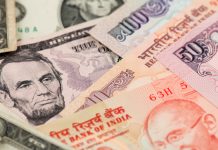- Indian Rupee (INR) rises for a second day
- Oil dropped sharply after weak Eurozone data
- US Dollar (USD) rises versus major peers
- US PMI data was stronger than forecast
The US Dollar Indian Rupee (USD/INR) exchange rate is falling, for a second straight day. The pair fell -0.10% in the previous session, settling on Friday at 83.07. At 16:30 UTC, USD/INR trades -0.04% at 83.03 and trades in a range of 82.97 to 83.13.
Indian Rupee is rising against the US dollar capitalising on the upbeat market mood and falling oil prices and despite the stock market being closed in India for a bank holiday.
Oil prices fell over 3%, falling for a third straight session after a slew of weaker economic data from the eurozone and Britain weighed on the outlook for energy demand.
Meanwhile, the upbeat data from the US raised the prospect of the Fed keeping rates high, which could also be interpreted as bad news for the demand outlook.
The US Dollar is falling against the Rupee but rising against major peers. The US Dollar Index, which measures the greenback versus a basket of major currencies, trades +0.72% at the time of writing at 106.30, rebounding from losses yesterday.
The US dollar is rising after stronger-than-expected data once again fueled bets that the Federal Reserve will need to keep interest rates elevated for a longer period of time in order to contain inflation.
U.S. business activity rose in October, defying expectations of a decline. The US Composite Purchasing Managers index, which tracks both manufacturing and service sector activity, rose to 51 in October, up from 50.2 in September and well above the 49.8 that the economists had pencilled in. it was also the highest level since July and the latest sign that the US economy is holding up better than expected. Even as the Federal Reserve raises interest rates aggressively.
Delving deeper into the data, the manufacturing sector rose out of contraction for the first time in five months thanks to rising new orders, and the service sector activity accelerated on signs that inflation pressures were easing.





